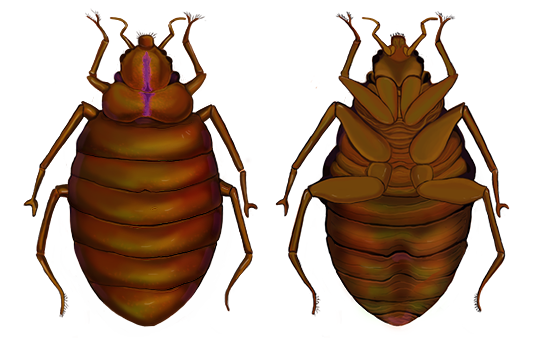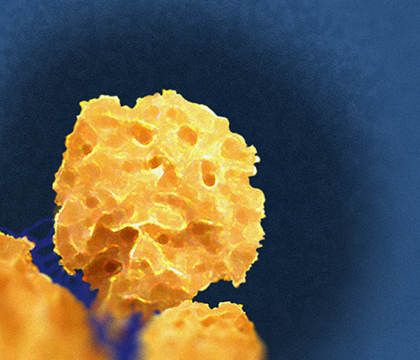Four Dead, Dozens Infected with Grogan's Disease in Northeastern - U.S
Associated Press
Atlanta, GA
The Center for Disease Control and Prevention (CDC) issued a public health statement Thursday morning in regards to an epidemic which has already claimed the lives of four people in the northeastern United States. Discovered in February of this year by Dr. Andrew Grogan of Worcester, Mass Grogan's Disease is transmitted by a non-indigenous bug that burrows under human and animal skin, feeding upon blood. The CDC reported that this bug carries a virus which, once in contact with the bloodstream, causes cardiopulmonary failure.
Dr. Sasha Thorpe, an attending physician in a Schenectady, N.Y. hospital, stated that this bug infected one of her medical students and claimed the life of one of her patients, the fourth person so far to die from Grogan's Disease.
Our hospital is in a state of panic right now,
Thorpe said. i’m afraid we might have to be quarantined until the medical community gets a handle on Grogan's Disease.
According to forensic entomologist Saul Adkin, the bug closely resembles a bed bug but has a very distinctive purple stripe down the center of its cephalothorax.
For that reason, Adkin and others have tentatively labelled the bug the Purpleback Bug.

The Purpleback Bug is responsible for the deaths of four patients and illnesses of several others in the Northeast United States.
Adkin, who is working alongside a team of medical and toxicology experts in a Syracuse,N.Y. laboratory to better understand the purpleback and Grogan's Disease, also stated that the bug's bite feels like a small prick in the skin.
It's not much different than a regular bed bug bite, or that of a mosquito, but without the subsequent itching that often happens,
he said.
Where Did This Bug Come From?
Dr. Andrew Grogan, for whom Grogan's Disease is named, speculated that the Purpleback bug came from the West Indies and arrived in the northeastern United States via migratory birds. The first casualty of Grogan's Disease was a 33-year-old woman from Burlington,Vt., who vacationed to Barbados over the winter. While in Barbados, she stumbled upon a double-crested cormorant nest.
She returned to her home in Vermont feeling fatigued and short of breath,
Grogan said in a report to the CDC after the woman's demise. For her, it was highly unusual because she was a woman who was in good overall health and took care of herself.
Grogan claimed that the bug was carried by cormorants migrating back to the Great Lakes and St. Lawrence River regions.
At this time, I can't find any other way this parasite suddenly appeared on the scene,
Grogan said in his report.

The digitally enhanced image of Grogan's Disease as shown under an electron microscope.
Ecologist Barbie Graylock, who for the last thirty years has specialized in both ornithology and insular biogeography, disagreed with Grogan’s theory.
Although it is true that birds such as cormorants may carry lice and ticks, there is no evidence to support the hypothesis that migratory birds are responsible for the transport of this bug to the Northeastern United States,
Graylock said in a press release last month.
When asked if it was possible that the Purpleback bug was coming from the West Indies, Adkin replied that anything was possible,
but also said that there wasn’t enough evidence at this time to unequivocally determine the bug’s origins.
Prevention Tips
Adkin said that due to the prevalence of bed bugs in the northeast right now, there is bound to be a lot of pandemonium over the potentiality of confusing bed bug bites with the Purpleback’s bite.
Right now, I believe that using bug repellant such as Deep Woods Off will deter the purpleback from biting,
Adkin said. This includes spraying your pets with repellant as well.
Thorpe agreed that using bug and insect repellant is an effective strategy, but due to the aggressiveness of Grogan’s Disease, other preventive measures need to be taken.
In addition to repellants, practice vigilant hygiene,
Thorpe instructed. Do everything you can to keep your home clean and free of clutter. Bathe or shower after any outdoor activities, especially hiking. Wear jeans rather than shorts, but if wearing shorts is your style, avoid high grasses and weeds. And keep an eye on the birds and animals in your area, including your pets. If they appear to be in distress, then they probably are.
Symptoms of Grogan’s Disease
Doctors Grogan and Thorpe, along with a team of other medical experts, compiled a list of symptoms each patient afflicted with Grogan’s Disease exhibited:
- Rash or
bump
at the site of the bug bite - Fatigue
- Shortness of breath, or breathing may be labored
- Irregular heart rate
- Sweating or cold chills
- Dry mouth and/or throat
- Pain in the head,neck,shoulders,arms,and/or abdomen. The pain may be dull or it may be severe, and it may be accompanied by paresthesia (tingling or numbness) in the hands and/or feet
Thorpe said that anyone experiencing these symptoms should first consult their primary care physician to rule out other health and medical concerns. She also urged anyone exhibiting any of these symptoms to remain as calm as possible and follow the advice of their doctors.
If your physician gives you a diagnosis of Grogan's Disease, you will likely need to be quarantined,
Thorpe said. This is an aggressive disease, but the entire medical community is just as aggressive in treating it. Hopefully, we’ll soon have a cure.